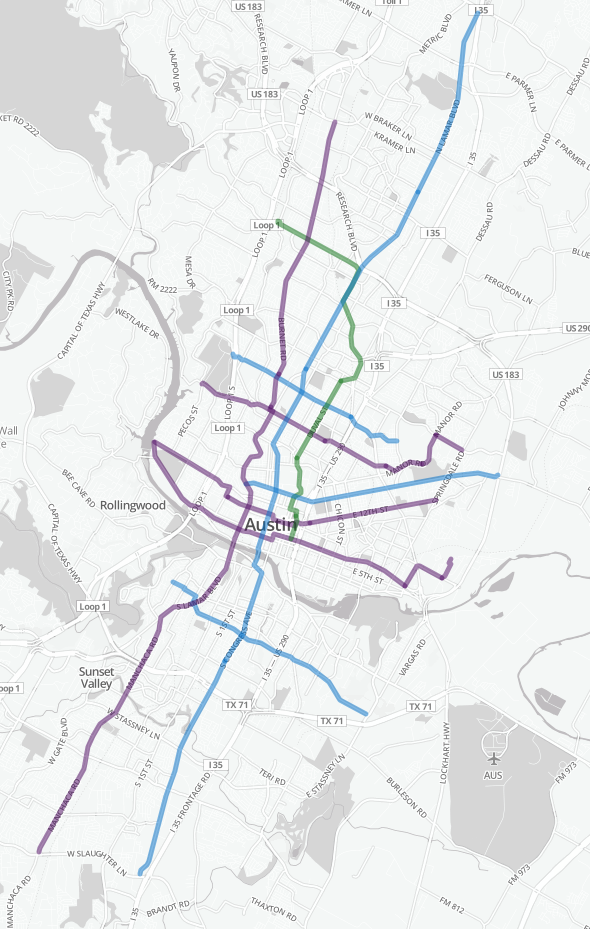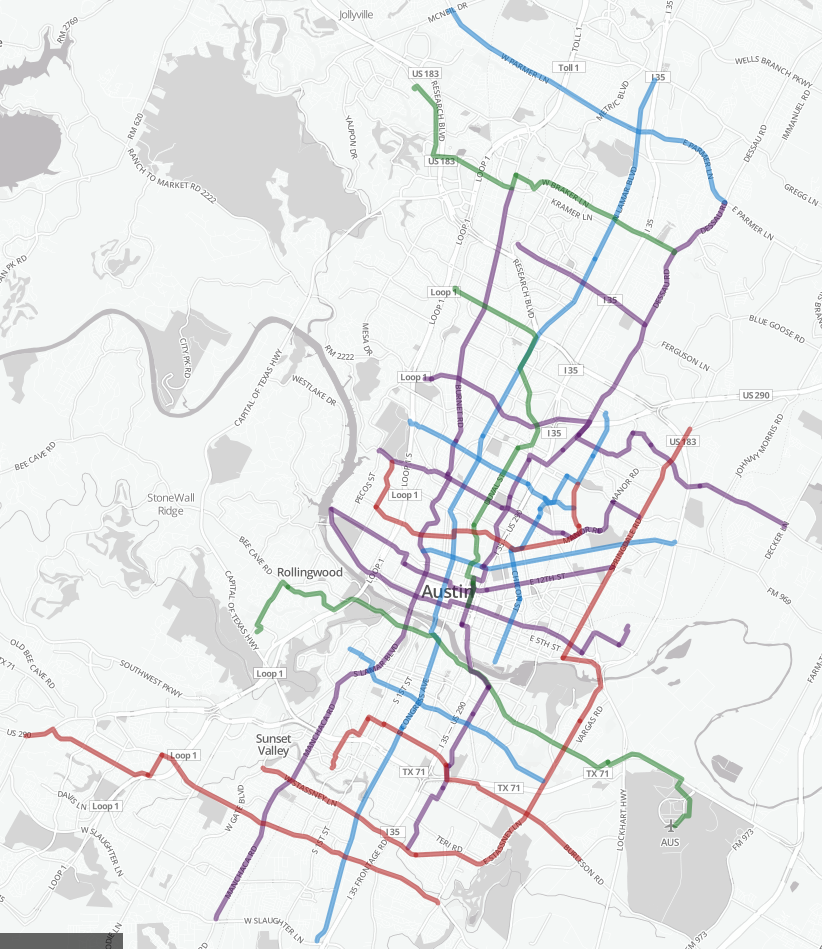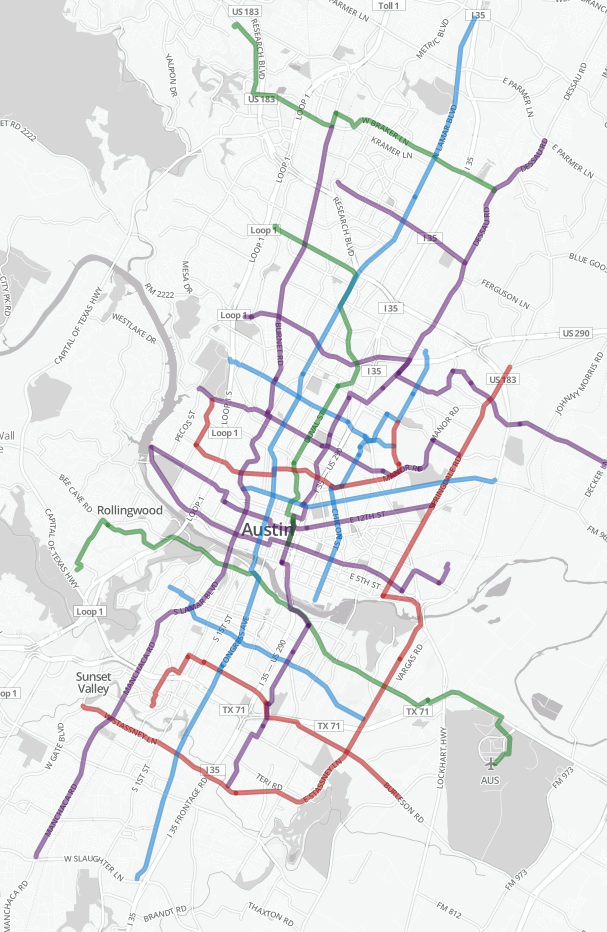Yesterday, I was exposed to a new tool that came out of Code For America: TransitMix. It’s intended as a tool for allowing lay people (and eventually professionals) to draw up transit systems. The map that I drew up (ideas you like are from Brad Absalom; ideas you dislike are from me)is a very preliminary interpretation of how ideas gleaned from reading posts on Jarrett Walker’s blog about a grid-based, transfer-happy system could work in Austin. For this post, I will call the system I drew up Reimagined in the spirit of Houston’s System Reimagining (on which Walker consulted). For speed, I didn’t take on MetroExpress (i.e. 983, 985, 990), the Flyers (e.g. 103, 142, 171), or the UT Shuttles (e.g. FA, WC, LA). I also ignored off-peak times for the same reason.
I constrained myself to reality in a few major ways: 1) using the same number of peak-hour buses that I calculated Cap Metro to use within MetroBus / MetroRapid (136 buses). This gives a rough idea that the new system has similar total expected costs. 2) I attempted to keep coverage for as many locations currently served by a bus as I could, 3) I did my best to give average run speeds based on real Capital Metro runtimes along segments, including rest times for driver breaks.
I only drew this up for Devil’s Advocate purposes at this time–I’m intrigued by it enough to throw a Saturday afternoon into making it, but I’m sure there are issues I haven’t thought about. It’s a very first cut, just an attempt to follow the principles and see where it leads.
The Map
The best way to get a look at the changes is to go to the site, where you can see the frequencies of each route. (You can also probably edit them; please don’t.) But I’m including a screenshot in case the map gets edited, and because I know many people don’t follow links:
The Changes
- Straighter routes. If you look at the shape of our current routes, they are all distorted around downtown. A straight shot ride on the #338 from 38th and Lamar to Barton Springs and Lamar typically takes around 11 minutes, but the same ride takes 28 minutes on the #3 bus, in order to go by UT and downtown. In my MetroBus, Reimagined map, the 3 takes Lamar directly. This avoids everything being bent around downtown, but requires transfers. (More on that later.) Another example of this is the #18, which wastes a couple minutes turning around backward right now in order to take 21st inside the UT campus instead of staying on MLK.
- Increase frequencies. The Reimagined system has much higher frequencies. This is both possible and necessary because of the time savings above. To show this, here is a 15-minute peak frequency map (i.e. only the routes that have frequencies of 15 minutes or greater):
 And here is the 20-minute peak frequency map:
And here is the 20-minute peak frequency map:
How it works
This is a transfer-heavy system. Let’s take a number of trips starting from Burnet and Anderson, right on the #3 route in either system. We’ll go to:
- Fourth and Guadalupe. In MetroBus, you take the 3 directly. In the Reimagined system, you take the #3 to the #4.
- Westmall. In Metrobus, you’d take a direct bus there. In the Reimagined system, you’d take the #3 to the Windsor Crosstown.
- Lamar and Barton Springs. You can take the #3 directly in either system.
- 7th and Chicon. In the old system, you transfer to the #4 at 4th and Guadalupe. In the Reimagined system, you transfer to the #4 at 5th and Lamar.
Let’s look at how long these take. The old system is on the top, the Reimagined system on bottom. Average wait times are calculated as half of the frequency. Both the first and second legs of trips with transfers are shown.
| Destination | Wait 1 | Trip 1 | Wait 2 | Trip 2 | Total Avg |
|---|---|---|---|---|---|
| Downtown | 11 | 33 | – | – | 44 |
| Westmall | 11 | 27 | – | – | 38 |
| Lamar / Barton Springs | 11 | 37 | – | – | 38 |
| 7th / Chicon | 11 | 33 | 15 | 11 | 70 |
| Destination | Wait 2 | Trip 1 | Wait 2 | Trip 2 | Total Avg |
| Downtown | 8 | 19 | 8 | 6 | 41 |
| Westmall | 8 | 17 | 10 | 6 | 41 |
| Lamar / Barton Springs | 8 | 20 | – | – | 28 |
| 7th / Chicon | 8 | 20 | 8 | 11 | 47 |
The old system keeps up with the Reimagined system on the routes that it hits precisely: for example, going straight to Westmall. On longer routes, they come out about even: the faster runtimes and higher frequencies of the straighter Reimagined routes make up for the need to transfer. If a point-to-point route doesn’t exist in the old system, the new system is much better. This is both because the better frequencies in the new system mean significantly less waiting time, and because the more distributed transfer points mean less wasted effort in taking indirect routes to transfer.


